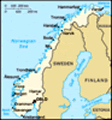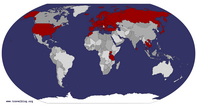Advertisement
Published: July 23rd 2019
Today we arrived in Honningsvåg, which is a port on the island of Magerøy (Meagre Island), or the Nordkapp (North Cape), the most Northern place in Europe - depending on who you talk to. Others may argue this point really is 2000 km north in Svalbard and my money’s on them to win this heated debate. Someone tried to say that this is the most northern part of mainland Europe, but actually it’s an island, so they got that wrong too - although connected with a tunnel. The name came from some sailor (Richard Chancellor) trying to find a northeastern passage through to India in 1533, who named it the North Cape. He never made it to India, so a failure all round.
We disembarked at 8am to an incredibly quiet town except for the noise of sea birds. A small harbour lined the small fishing town, population 2,100. The buildings are all post WW2 as they were all bombed except the church, the survival of which inspired the townspeople to rebuild.
Glyn and I had prebooked an independent tour after checking TripAdvisor with a small family company called Blue Puffin. Two other passengers joined us on the trip
and it was great just being four of us plus a guide, rather than a coach load. Our tour guide was a Polish lady called Monika; Norwegians generally don’t work in tourism because they don’t like the long and erratic hours (especially in the midnight sun areas) and I don’t think they like the pay either. If they own a shop and a cruise ship arrives out of hours (around 104 come per year), they certainly won’t be opening; they value family and personal time far more. Surprisingly though, the sparsely populated area is quite diverse with Spanish, Germans, French and an American residing there.
Summer had started here two days ago and it had been 23 degrees yesterday - people went nuts and hung out on the beach, kids ventured into the sea! Today it was around 14 degrees and foggy as Monika drove us in her green van to her home village of Kamøyvær to collect a forgotten cable. We saw her lovely house at the edge of the tiny village where the local entertainment is watching your neighbours through binoculars.
The island was lush and covered in small wildflowers that only get to flourish for
6 weeks a year. Winter can last around 8 months on average and the 100-150km/h winds mean that there are no naturally growing trees. However, people do grow them in their gardens and cover them during the winter, they also have garden fences in the hope of deterring the reindeer from eating their flowers. The reason people first settled here is because the Barents Sea never freezes, so fishing is always possible. The wonderful Gulf Stream makes the area on average 20 degrees higher than other places at similar latitude. It’s generally always windy though.
After fishing, tourism is the second industry, although predictably far more so in the summer. People do partake in cross country skiing though in winter, it’s hard to find the entrance to the hotel because of the snow burying it. A lot of locals tend to abandon the area in winter, often travelling to warmer climes such as Cyprus.
Honningsvåg is the main town of the island, where 320 children attend the school. There is also a college of maritime studies so the ‘kids can become captains on the cruise ships’. There’s no hospital, but a healthcare centre; they do have a small
airport to transport people to a hospital 200km away. The planes are also like a bus service, especially in winter when the roads can be closed for weeks at a time. Yellow signs on the roadsides contain timetables of when the next snow plow will arrive. The people live in a social bubble, in that there’s no crime (you can leave your houses and vehicles unlocked) and no dangerous animals, so no worries about the kids playing outside. Monika left her baby sleeping outside in January regularly to acclimatise him as he grew up - I presume with blankets - he’s a bonny looking toddler now, so she knew what she was doing.
However, the population is dwindling with only 25 babies being born per year. Women are leaving to get educations and careers, no longer content with being fishermen’s wives.
There are around 5000-6000 reindeer on the cape which belong to the indigenous Sami people who are nomadic. It’s rude to ask a Sami how many reindeer they own as it’s the same as asking how much dosh you have in the bank. They follow the reindeer way of life which is eating and sleeping - sounds
great! There’s a local Sami place where you could once buy genuine crafts and have your photo taken with a proper Sami. Sadly he’s died recently and his sons made it commercial, dressing up in traditional gear when tourists arrive and selling plastic trolls made in China. One of them is a dentist, so why he needs to do this is anyone’s guess, but Monika no longer takes guests there.
The North Cape is a 300 metre high cliff overlooking the Barents Sea, with a globe monument for tourist photographs. A nearby information centre appears to be one story high, but goes underground by a few more floors, thus not overpowering the landscape. Like most places, it is inaccessible during the winter, although there is no permafrost as it’s sub-Arctic here or also known as Tundra.
Monika drove us to a small fishing village of Skarsvåg to see king crabs. These invasive species I believe were introduced by Russians and have taken over. The locals make a lot of money selling them live to South Koreans. Around here a king crab dinner would cost you €50 and then you would only get three legs. Bizarrely there are no
fish shops in the area despite there being fish factories; you either go fishing yourself and get matey with fisherfolk and trade booze for it as Monika does. Donning long gloves, Monika picked up two of the huge live crabs, so we could see up close the difference between male and female. The latter was ferocious and ripped the gloves from her hands.
In this village we saw more crabs than people. Not hard as we only saw one other person. There used to be a population of 300 but once the school shut, it’s 45. Apparently there are 15 cats but disappointingly I didn’t see any.
We returned to the larger Kamøyvær (population 68) where the multi coloured houses were far more visible now that the fog had dispersed. Again I was tricked into believing there were a cats here getting fat on fish, but not one put in an appearance. We actually saw a couple of other people hanging around the tiny horse shoe shaped harbour.
We stopped at a few viewpoints on the way back and got close to reindeer. Upon returning to Honningsvåg I saw my first cat - having a pee by
a wall! I couldn’t go and meet it as Monika was more concerned about taking us to the centre of town where the tour ended.
We still had a few hours left and had a wander, meeting Andrew and Mo (part of our cruise tribe) who told us they’d seen a ton of birds on their tour. We then found the WW2 survivor church that cost ££ to enter (so we didn’t).
At this point my wonderful hubby spotted a gorgeous and extremely hairy Norwegian Forest Cat sitting in the grass by the harbour. It was looking particularly smug and totally unconcerned as I got closer and stroked it. The soft fur was incredibly thick and the face very beautiful. I could have spent a lot longer with it than I was allowed.
Wandering further around, we soon realised there wasn’t much else to see. We considered going to the museum, particularly because of needing the loo, but this was expensive and we decided not worth it. Stopping by a gallery that sold the work of Monika’s German mate, we bought two of the cheapest prints and headed back to the ship for afternoon tea having missed lunch.
After a short nap, we hung out on the sticky out bit to watch the coast as we left Honningsvåg at around 6.30pm. The plan was to photograph the cape from the sea but were on the wrong side, so quickly moved in on the other sticky out bit, where others soon left as our tribe invaded. As we headed out to sea, the amount of people on deck dwindled. But Glyn, Richard, Sonja, Mo, Andrew and I hung out in the cold for sometime, having a laugh and not seeing any whales but many birds flapping about as birds do. There was much discussion as to why the North Cape should be named so when it isn’t, but it turns out it was a political thing, where a Norwegian king in the 1800s was claiming land for Norway. However, if you want the exact and correct description, (and I did) it is the most Northern place in Europe accessible by road, because there is another bit inaccessible by road nearby that is further north called Knivskjellodden that takes a few hours to hike. Why no one built a road there is anyone’s guess.
We had an early night but with the portholes open. The light stayed the same throughout the night, so it was impossible to guess the time without a watch.
Advertisement
Tot: 0.061s; Tpl: 0.014s; cc: 7; qc: 24; dbt: 0.0368s; 1; m:domysql w:travelblog (10.17.0.13); sld: 1;
; mem: 1.1mb











